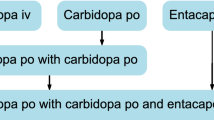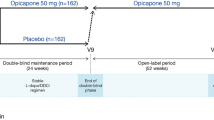Abstract
Background and objectives
Opicapone is a novel third generation catechol-O-methyltransferase (COMT) inhibitor. The purpose of this study was to compare the levodopa pharmacokinetic profile throughout a day driven by the COMT inhibition either following repeated doses of opicapone or concomitant administration with entacapone.
Methods
A randomized, double-blind, gender-balanced, parallel-group study was performed in 4 groups of 20 healthy subjects each. Four subjects in each group received placebo during the entire study. Sixteen subjects in one group received placebo once daily for 11 days and on day 12, 200 mg entacapone concomitantly with each levodopa/carbidopa dose (three times separated by a 5-h interval). Sixteen subjects in each of the remaining three groups received respectively 25, 50, and 75 mg opicapone once daily for 11 days and on day 12, placebo concomitantly with each levodopa/carbidopa dose.
Results
Levodopa minimum plasma concentration (Cmin) for each levodopa/carbidopa dose and for the mean of all levodopa/carbidopa doses increased substantially with all active treatments (entacapone and opicapone) when compared to the control group (placebo), with values ranging from 1.7-fold (200 mg entacapone) to 3.3-fold (75 mg opicapone). No statistical difference was found for levodopa peak of systemic exposure (as assessed by maximum observed plasma concentration (Cmax)) between all active treatments and placebo. A significant increase in the levodopa extent of systemic exposure (as assessed by concentration-time curve (AUC)) occurred with all opicapone treatments in relation to placebo. No statistical difference was found for levodopa AUC when entacapone was compared to placebo. When compared to entacapone, both 50 and 75 mg opicapone presented a significant increase for the levodopa AUC. All active treatments significantly inhibited both peak (as assessed by Emax) and extent (as assessed by effect-time curve (AUEC)) of the COMT activity in relation to placebo. When compared to entacapone, all opicapone treatments significantly decreased the extent (AUEC) of the COMT activity due to a long-lasting and sustained effect. The tolerability profile was favorable for all active treatments.
Conclusion
Opicapone, a novel third generation COMT inhibitor, when compared to entacapone, provides a superior response upon the bioavailability of levodopa associated to more pronounced, long-lasting, and sustained COMT inhibition. The tolerability profile was favorable. On the basis of the results presented in this study and along with the earlier pharmacology studies, it is anticipated that opicapone adjunct therapy at the dosages of 25 and 50 mg will provide an enhancement in levodopa availability that will translate into clinical benefit for Parkinson’s disease patients.



Similar content being viewed by others
References
Morgan JC, Sethi KD (2006) Emerging drugs for Parkinson’s disease. Expert Opin Emerg Drugs 11(3):403–417
Schapira AH, Emre M, Jenner P, Poewe W (2009) Levodopa in the treatment of Parkinson’s disease. Eur J Neurol: Off J Eur Fed Neurol Soc 16(9):982–989. doi:10.1111/j.1468-1331.2009.02697.x
Dingemanse J (2000) Issues important for rational COMT inhibition. Neurology 55(11 Suppl 4):S24–S27, discussion S28-32
Palma PN, Bonifácio MJ, Almeida L, Soares-Da-Silva P (2007) Restoring dopamine levels. In: Simth HJ, Simons C, Sewell RDE (eds) Protein misfolding in neurodegenerative diseases: mechanisms and therapeutic strategies. CRC Press, pp415-445
Gomes P, Soares-da-Silva P (1999) Interaction between L-DOPA and 3-O-methyl-L-DOPA for transport in immortalised rat capillary cerebral endothelial cells. Neuropharmacology 38(9):1371–1380
Gervas JJ, Muradas V, Bazan E, Aguado EG, de Yebenes JG (1983) Effects of 3-OM-dopa on monoamine metabolism in rat brain. Neurology 33(3):278–282
Nutt JG, Woodward WR, Gancher ST, Merrick D (1987) 3-O-methyldopa and the response to levodopa in Parkinson’s disease. Ann Neurol 21(6):584–588. doi:10.1002/ana.410210610
Wade LA, Katzman R (1975) 3-O-methyldopa uptake and inhibition of L-dopa at the blood-brain barrier. Life Sci 17(1):131–136
Olanow CW, Stocchi F (2004) COMT inhibitors in Parkinson’s disease: can they prevent and/or reverse levodopa-induced motor complications? Neurology 62(1 Suppl 1):S72–S81
Bonifácio MJ, Palma PN, Almeida L, Soares-da-Silva P (2007) Catechol-O-methyltransferase and its inhibitors in Parkinson’s disease. CNS Drug Rev 13:352–379. doi:10.1111/j.1527-3458.2007.00020.x
Lang AE, Lees A (2002) Management of Parkinson’s disease: an evidence-based review. Mov Disord 17(Suppl 4):S45–S51
Brooks DJ (2004) Safety and tolerability of COMT inhibitors. Neurology 62(1 Suppl 1):S39–S46
Kiss LE, Ferreira HS, Torrao L, Bonifacio MJ, Palma PN, Soares-da-Silva P, Learmonth DA (2010) Discovery of a long-acting, peripherally selective inhibitor of catechol-O-methyltransferase. J Med Chem 53(8):3396–3411
Palma PN, Bonifácio MJ, Loureiro AI, Soares-da-Silva P (2012) Computation of the binding affinities of catechol-O-methyltransferase inhibitors: multisubstate relative free energy calculations. J Comput Chem 33(9):970–986
Bonifácio MJ, Torrão L, Loureiro AI, Wright LC, Soares-da-Silva P (2012) Opicapone: characterization of a novel peripheral long-acting catechol-O-methyltransferase inhibitior. Parkinsonism Relat Disord 18(S2):S125
Bonifácio MJ, Sutcliffe JS, Torrão L, Wright LC, Soares-da-Silva P (2012) Brain and peripheral levodopa pharmacokinetics in the Cynomolgus monkey following administration of opicapone, a novel catechol-O-methyltransferase inhibitor. Parkinsonism Relat Disord 18(S2):S125
Almeida L, Rocha J-F, Falcão A, Palma N, Loureiro AI, Pinto R, Bonifácio M, Wright LC, Nunes T, Soares-da-Silva P (2013) Pharmacokinetics, pharmacodynamics and tolerability of opicapone, a novel catechol-O-methyltransferase inhibitor, in healthy subjects: prediction of slow enzyme-inhibitor complex dissociation of a short-living and very long-acting inhibitor. Clin Pharmacokinet 52(2):139–151
Rocha JF, Almeida L, Falcao A, Palma PN, Loureiro AI, Pinto R, Bonifacio MJ, Wright LC, Nunes T, Soares-da-Silva P (2013) Opicapone: a short lived and very long acting novel catechol-O-methyltransferase inhibitor following multiple dose administration in healthy subjects. Br J Clin Pharmacol 76(5):763–775. doi:10.1111/bcp.12081
Ferreira JJ, Rocha JF, Falcão A, Pinto R, Nunes T, Soares-da-Silva P (2013) Effect of opicapone multiple-dose regimens on levodopa pharmacokinetics, motor response, and erythrocyte-COMT activity in Parkinson’s patients co-administered with levodopa/dopa-decarboxylase inhibitor. Mov Disord 28(Suppl 1):S154–S431
Ferreira JJ, Rocha JF, Santos A, Nunes T, Soares-da-Silva P (2012) The design of a double-blind, placebo- and active-controlled, multi-national phase-III trial in patients with Parkinson’s disease and end-of-dose motor fluctuations: Opicapone superiority vs. placebo and non-inferiority vs. entacapone. Mov Disord 27(Suppl 1):S118
Lees A, Costa R, Oliveira C, Lopes N, Nunes T, Soares-da-Silva P (2012) The design of a double-blind, placebo-controlled, multi-national phase-III trial in patients with Parkinson’s disease and end-of-dose motor fluctuations: opicapone superiority vs. placebo. Mov Disord 27(Suppl 1):S127
Silveira P, Vaz-da-Silva M, Almeida L, Maia J, Falcão A, Loureiro AI, Torrão L, Machado R, Wright LC, Soares-da-Silva P (2003) Pharmacokinetic-pharmacodynamic interaction between BIA 3-202, a novel COMT inhibitor, and levodopa/benserazide. Eur J Clin Pharmacol 59:603–609
Vieira-Coelho MA, Soares-da-Silva P (1996) Ontogenic aspects of liver and kidney catechol-O-methyltransferase sensitivity to tolcapone. Br J Pharmacol 117(3):516–520
Vieira-Coelho MA, Soares-da-Silva P (1999) Effects of tolcapone upon soluble and membrane-bound brain and liver catechol-O-methyltransferase. Brain Res 821(1):69–78
Heikkinen H, Varhe A, Laine T, Puttonen J, Kela M, Kaakkola S, Reinikainen K (2002) Entacapone improves the availability of L-dopa in plasma by decreasing its peripheral metabolism independent of L-dopa/carbidopa dose. Br J Clin Pharmacol 54(4):363–371
Keranen T, Gordin A, Harjola VP, Karlsson M, Korpela K, Pentikainen PJ, Rita H, Seppala L, Wikberg T (1993) The effect of catechol-O-methyl transferase inhibition by entacapone on the pharmacokinetics and metabolism of levodopa in healthy volunteers. Clin Neuropharmacol 16(2):145–156
Rouru J, Gordin A, Huupponen R, Huhtala S, Savontaus E, Korpela K, Reinikainen K, Scheinin M (1999) Pharmacokinetics of oral entacapone after frequent multiple dosing and effects on levodopa disposition. Eur J Clin Pharmacol 55(6):461–467
Kurlan R, Nutt JG, Woodward WR, Rothfield K, Lichter D, Miller C, Carter JH, Shoulson I (1988) Duodenal and gastric delivery of levodopa in parkinsonism. Ann Neurol 23(6):589–595. doi:10.1002/ana.410230611
Mouradian MM, Heuser IJ, Baronti F, Fabbrini G, Juncos JL, Chase TN (1989) Pathogenesis of dyskinesias in Parkinson’s disease. Ann Neurol 25(5):523–526. doi:10.1002/ana.410250521
Stocchi F, Vacca L, Ruggieri S, Olanow CW (2005) Intermittent vs continuous levodopa administration in patients with advanced Parkinson disease: a clinical and pharmacokinetic study. Arch Neurol 62(6):905–910. doi:10.1001/archneur.62.6.905
Ingman K, Naukkarinen T, Vahteristo M, Korpela I, Kuoppamaki M, Ellmen J (2012) The effect of different dosing regimens of levodopa/carbidopa/entacapone on plasma levodopa concentrations. Eur J Clin Pharmacol 68(3):281–289. doi:10.1007/s00228-011-1121-5
Jorga K, Banken L, Fotteler B, Snell P, Steimer JL (2000) Population pharmacokinetics of levodopa in patients with Parkinson’s disease treated with tolcapone. Clin Pharmacol Ther 67(6):610–620. doi:10.1067/mcp.2000.106795
Author information
Authors and Affiliations
Corresponding author
Electronic supplementary material
Below is the link to the electronic supplementary material.
ESM 1
(PDF 39 kb)
Rights and permissions
About this article
Cite this article
Rocha, JF., Falcão, A., Santos, A. et al. Effect of opicapone and entacapone upon levodopa pharmacokinetics during three daily levodopa administrations. Eur J Clin Pharmacol 70, 1059–1071 (2014). https://doi.org/10.1007/s00228-014-1701-2
Received:
Accepted:
Published:
Issue Date:
DOI: https://doi.org/10.1007/s00228-014-1701-2




